Related Research Articles
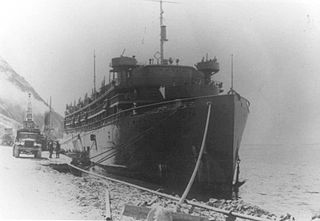
Dorchester was a coastal passenger steamship requisitioned and operated by the War Shipping Administration (WSA) in January 1942 for wartime use as a troop ship allocated to United States Army requirements. The ship was operated for WSA by its agent Atlantic, Gulf & West Indies Steamship Lines (Agwilines). The ship was in convoy SG 19 from New York to Greenland transiting the Labrador Sea when it was torpedoed by a German U-boat on February 3, 1943. The ship sank with loss of 674 of the 904 on board with one of the 230 survivors lost after rescue. The story of four Army chaplains, known as the "Four Chaplains" or the "Immortal Chaplains," who all gave away their life jackets to save others before they died, gained fame and led to many memorials.

USS Ariel (AF-22) was the United Fruit Company cargo and passenger liner Peten, renamed Jamaica in 1937, that served as a United States Navy Mizar-class stores ship in World War II.
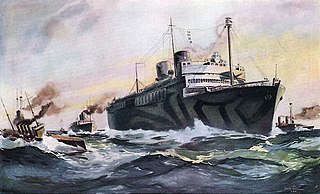
USS Siboney (ID-2999) was a ship transport for the United States Navy during World War I. She was the sister ship of USS Orizaba (ID-1536) but neither was part of a ship class. Launched as SS Oriente, she was soon renamed after Siboney, Cuba, a landing site of United States forces during the Spanish–American War. After her navy service ended, she was SS Siboney for the New York & Cuba Mail Steamship Co.. The ship was operated under charter by American Export Lines beginning in late 1940. During World War II she served the U.S. Army as transport USAT Siboney and as hospital ship USAHS Charles A. Stafford.

MS Klipfontein was a Dutch ocean liner launched in March 1939 and delivered 29 July intended for South African service. Declaration of war in Europe, including Britain and South Africa declaring war on Germany, resulted in the ship being transferred to service between the Dutch East Indies and the west coast of North America. After the German invasion of the Netherlands in May 1939, with the Dutch government in exile in London, the ship supported the Allied war effort. After entry of the United States into the war the ship was operated by Dutch agents of the U.S. War Shipping Administration (WSA) from February 1942 to February 1946 as a troopship from the U.S. West Coast to Pacific war zones.

USS Mizar (AF-12) was the United Fruit Company fruit, mail and passenger liner Quirigua that served as a United States Navy Mizar-class stores ship in World War II.

USS Talamanca (AF-15) was the United Fruit Company cargo and passenger liner Talamanca that served as a United States Navy Mizar-class stores ship in World War II.

USS Tarazed (AF-13) was the United Fruit Company cargo and passenger liner Chiriqui that was acquired by the United States Navy through a sub bareboat charter from the War Shipping Administration (WSA) which acquired the ship by bareboat charter from the company. The ship served as a Mizar-class stores ship in World War II. In peacetime before and after the war she carried fruit and passengers; in war she supplied troops and ships in the field. In 1958 she was sold to a German shipping line and renamed Blexen which was scrapped in 1971 after 39 years' service.

USS Merak (AF-21), the second Navy ship of the name, was the United Fruit Company cargo and passenger liner Veragua that served as a United States Navy Mizar-class stores ship in World War II.
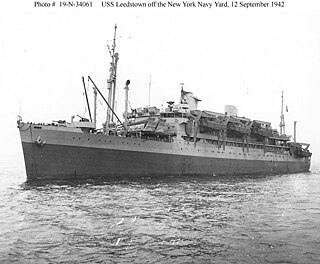
USS Leedstown (AP-73), built as the Grace Line passenger and cargo ocean liner SS Santa Lucia, served as a United States Navy amphibious assault ship in World War II. The ship had first been turned over to the War Shipping Administration (WSA) and operated by Grace Line as the WSA agent from February to August 1942 in the Pacific. In August the ship, at New York, was turned over to the Navy under sub-bareboat charter from WSA. She was sunk 9 November 1942 off the Algerian coast by a German submarine after German bombers caused damage the day before.

USS George F. Elliott (AP-105) was a cargo liner built for the Mississippi Shipping Company as SS Delbrasil for operation between New Orleans and the east coast of South America in 1939 by its operator, Delta Line. The ship entered that service and operated until taken over by the War Shipping Administration (WSA) on 28 April 1942 for operation by Delta Line acting as WSA's agent. On 25 August 1943 WSA allocated the ship to the Navy for conversion to a troop transport commissioned and operated by the Navy for the duration of the war. Ownership of the ship was transferred from Mississippi Shipping to WSA on 4 February 1944 while under Navy operation and was retained until sale to American South African Lines on 22 December 1948. The ship was renamed African Endeavor until returned as a trade in to the Maritime Commission on 22 September 1960 for layup in the James River reserve fleet and later sold to Boston Metals for scrapping.

Koninklijke Paketvaart-Maatschappij, better known as KPM, was a Dutch shipping company (1888–1966) in the Netherlands East Indies, now Indonesia. It was the dominant inter-island shipping line in Indonesia during the last half century of the colonial era.

SS Manchuria was a passenger and cargo liner launched 1903 for the San Francisco-trans Pacific service of the Pacific Mail Steamship Company. During World War I the ship was commissioned 25 April 1918–11 September 1919 for United States Navy service as USS Manchuria (ID-1633). After return to civilian service the ship was acquired by the Dollar Steamship Line in 1928 until that line suffered financial difficulties in 1938 and ownership of Manchuria was taken over by the United States Maritime Commission which chartered the ship to American President Lines which operated her as President Johnson. During World War II she operated as a War Shipping Administration transport with American President Lines its agent allocated to United States Army requirements. After World War II, she was returned to American President Lines, sold and renamed Santa Cruz. The liner was scrapped in Italy in 1952.

The Type C4-class ship were the largest cargo ships built by the United States Maritime Commission (MARCOM) during World War II. The design was originally developed for the American-Hawaiian Lines in 1941, but in late 1941 the plans were taken over by the MARCOM.

SS Point Bonita was constructed in 1918 and launched 27 March 1918 after a hull being built for foreign owners at Albina Engine and Machine Works was requisitioned during World War I by the United States Shipping Board (USSB). The ship saw service as the Navy transport USS Point Bonita, assigned Identification Number 3496, from 7 October 1918 to 7 April 1919, was returned to the USSB and saw civilian service with several commercial companies as San Pedro and Oliver Olson before again seeing service in World War II as USS Camanga (AG-42). After return to commercial service as Oliver Olson the ship was wrecked at the entrance to Bandon harbor in Oregon.

USAHS Acadia was the first United States Army Hospital Ship in World War II. Built in 1932 by Newport News Shipbuilding as a civilian passenger/cargo ocean liner for the Eastern Steamship Lines, the ship was in US coastal and Caribbean service prior to its acquisition by the US Maritime Administration in 1941.

SS Antigua was a United Fruit Company passenger and refrigerated cargo liner completed as one of six nearly identical vessels, three built by Newport News Shipbuilding and three by Bethlehem Shipbuilding Corporation, for operation by the company's subsidiary the United Mail Steamship Company. The ship was the first of the ships built by Bethlehem Shipbuilding Corporation, Quincy, Massachusetts.

Registan, built 1910, was the first name for a ship serving fifty years under the later names Guantanamo, USS Guantanamo (ID-1637), Comerio, Vittorin, Grey Lag and finally Hai Lung until scrapping in 1960. The ship transported gunpowder and munitions during World War I as USS Guantanamo and as a cargo ship during World War II for the War Shipping Administration (WSA). After 12 October 1943 the ship was assigned to the Southwest Pacific Area command's permanent local fleet as the United States Army transport Grey Lag with that fleet's number X-101. In April 1945 she was one of the transports towing large barges from Australia and New Guinea to the Philippines after that concept to mitigate shipping shortages had been proven feasible. In 1946 the ship was sold to the Republic of China and renamed Hai Lung.
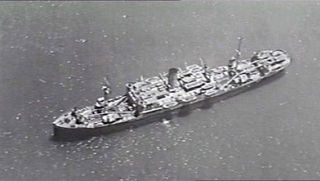
Contessa was a refrigerated cargo and passenger ship of 5,512 GRT built by Barclay, Curle & Co., Glasgow for Vaccaro Brothers & Company launched 18 February 1930. The ship, along with sister ship Cefalu, served ports in the United States, Cuba, and Central America specifically La Ceiba, Honduras which is still a port for the fruit trade. The ship became part of the Standard Fruit Company, a company established by Vaccaro Brothers, and operated as a cargo passenger vessel until taken over at New Orleans by the War Shipping Administration (WSA) on 29 May 1942 with Standard Fruit Company remaining as the WSA operating agent. The ship was later bareboat sub chartered to the United States War Department 14 July 1943 and operated in the Army's Southwest Pacific Area local fleet under the local fleet number X-96 from 18 September 1943 into 1945 as a troop ship. The ship was returned to WSA with Standard Fruit again its agent on 28 May 1946 in Brooklyn until returned to the company for commercial operation at New Orleans on 20 August 1947.

USAT Cuba was the passenger ship Cuba of the Peninsular & Occidental Steamship Company built by William Cramp & Sons Shipbuilding Company, Philadelphia in 1920 and placed into operation in 1921 for scheduled passenger and freight service between Tampa, Key West and Havana.
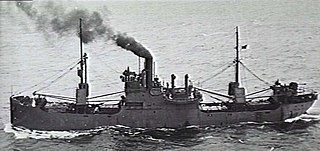
SS Lake Elsmere was an Emergency Fleet Corporation (EFC) Design 1074 cargo ship built for the United States Shipping Board (USSB) during the massive shipbuilding effort of World War I.
References
- 1 2 3 Maritime Administration Ship History &Monterey.
- 1 2 3 4 5 6 Pacific Marine Review & January, p. 26.
- 1 2 3 4 5 6 Lloyds 1943–44.
- 1 2 3 4 5 6 7 8 Maritime Administration Ship History &Puerto Rico.
- 1 2 3 4 5 Pacific Marine Review & February, pp. 49–50.
- ↑ Colton 2014.
- ↑ Grover 1987, pp. 10, 15.
- ↑ Bykofsky & Larson 1990, p. 26.
- ↑ Weiss & Leonard 1920, pp. 150–158.
- ↑ United States Shipping Board 1933, p. 28.
- ↑ Pacific Marine Review & February, p. 50.
- ↑ Pacific Marine Review & February, p. 49.
- ↑ Pacific Marine Review & February, pp. 50–51.
- ↑ Larsson 2009.
- ↑ Larsson 2011.
- 1 2 3 Roberts, Stephen S. 2007.
- 1 2 Bykofsky & Larson 1990, pp. 25–26.